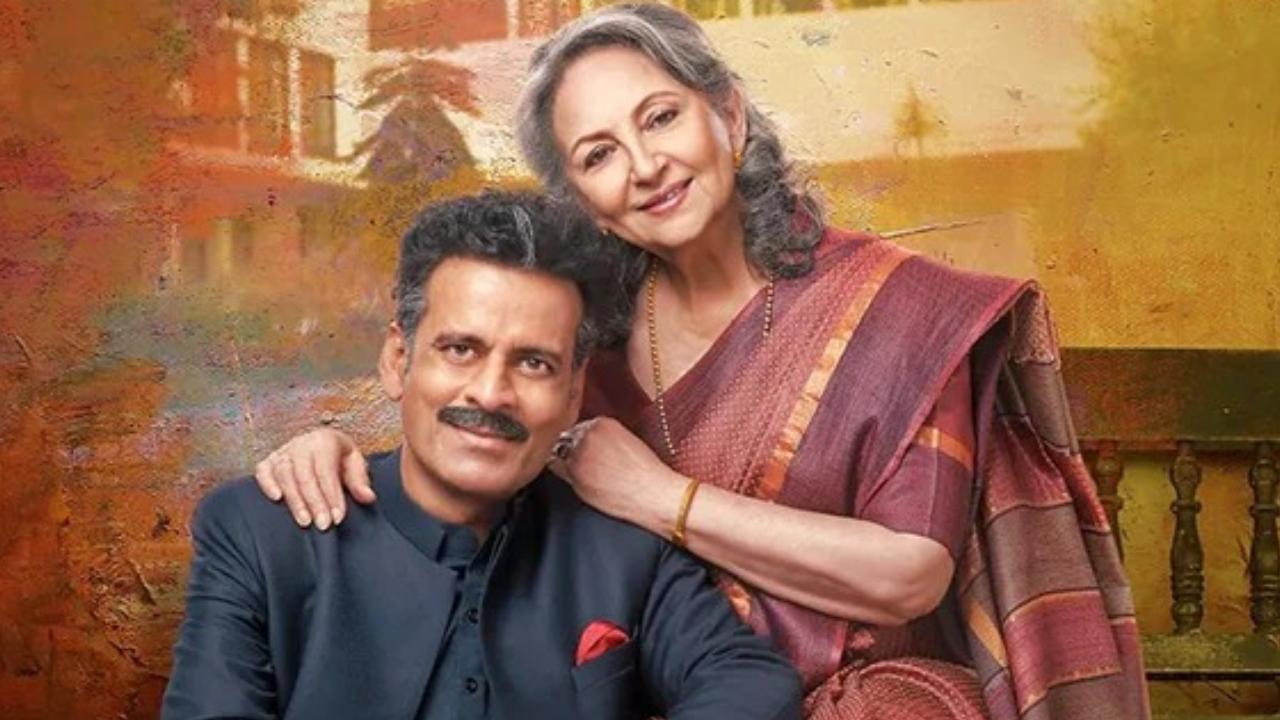Gulmohar has aptly premiered on a popular OTT platform, waiting for your Sunday. Just press play, you don’t even have to go for it

Manoj Bajpayee and Sharmila Tagore in a still from 'Gulmohar'
Movie name: Gulmohar
On: Disney+ Hotstar
Director: Rahul V Chittella
Actors: Manoj Bajpayee, Sharmila Tagore
Rating: 3/5
I love the fact that this film pretty much begins with a song, set in a large living room, with several guests, feasting over drinks, while a live-singer (Talat Aziz, as a family friend) plays the music.
Everyone joins in, impromptu-karaoke, or breaks into a gentle dance. This is a song genre as old as the star-system in Bollywood. And you could make a full playlist of tracks with the same setting/purpose, with your favourite on top.
Mine is ‘Huzoor is kadar’ (from Masoom, 1982)—personally choreographed by the actors Naseeruddin Shah, Saeed Jaffrey on screen. Set in a Delhi drawing room.
As is Gulmohar. Although as a movie in the same city, this is probably closer to the other Naseer starrer, Monsoon Wedding (2001), wherein Manoj Bajpayee plays the affectionately ageing father, in a family of rich Punjabis of South Delhi. So let’s just call it Man(oj)-soon Wedding (okay, let’s not!).
The Batras are the Suris here. What you instantly imagine of these Dilli business folk, self-made in the first generation, is they would’ve moved as refugees during Partition, perhaps, and built life anew—offering their following generations enough privilege to deal in first world problems subsequently.
The family in this film comes from Jamshedpur. Multiple generations reside in a posh mansion, that the patriarch left behind. There’s clearly space for all in the house—enough that the current daddy (Bajpayee) believes everyone lives too parallel a life. Including, in fact, his old mother (Sharmila Tagore).
That the Lutyens’ bungalow is now on sale to real-estate developers, who’d expectedly build multiple high-rises in the same compound, we find three generations—between grandmom (Tagore), son (Bajpayee), his wife, and children—potentially going their own directions, once the joint family dissolves, simultaneously.
Frankly you can’t fault the film’s premise—it’s got a lot of commentary already built into it. Outside of the Batras, there is another semi-visible world of domestic staff—cook, cleaner, watchman—servicing this first world, that the camera aims its gaze on. And this is where the settings and the characters feel more as if under a gaze, rather than naturally convincing or authentic.
In fact, even for the portrayal of Delhi’s supposedly stiff-upper-lip, St Stephen’s upper-class, it’s cool to see how the daughter-in-law (Simran Bagga) and mother-in-law (Tagore), who is 76, went to the same said college. Except that between 1949 and 1975, Stephen’s did not admit women, and there’s no way Tagore’s character could’ve enrolled any time before or after.
Bajpayee’s character is from “across from the road,” as in Hindu College. Education might matter here a li’l bit, because the family runs the venerable “Delhi Press, founded in 1975”. The Naths run that actual company (founded in 1939, with the erudite Caravan magazine). I know: these absolutely random facts are pointed out purely for fun—they’re called fun-facts!
Either way, class, generation (age), and gender are arguably the only real divides in the world—baaki sab (rest), politics. To weave a story, sincerely/simply shot/executed, with several threads exploring all three gives Gulmohar the legs to stand on, as a script, written with care (director Rahul Chittella, Arpita Mukherjee), and indeed, with performers on the spot.
Speaking of which, in Gulmohar, you just to wish to see more of her, meaning the gentle Tagore, of course. Even when she talks in a twang so resolutely elite Delhi, yet so polite/calm that it can be annoying sometimes—there is grace she brings to the screen, that only comes with age, I guess.
I felt the same about another Satyajit Ray actor, Soumitra Chatterjee, in some of his later films—in particular the under-rated, equally engaging family story, Belasheshe (2015). Essential to mention also that Hindi cinema’s ‘Soumitro’, Amol Palekar, the ‘70s Indian middle-class hero, plays a wily part here.
You’d think Bajpayee would stand out as far being a Batra after all! Well, there’s adequate backstory for it too. Beyond that, as the star-actor, in the more satisfying second innings of his career—there’s nothing that Bajpayee does that you don’t root for him to win the part/picture/audience, absolutely . He’s out there for the same purpose.
So is the entire cast in this ensemble picture. Many such films have disappeared from public memory, mainly because they lacked the heft of famous faces on screen to bring audiences in.
Too many such. One that comes to mind, right away, because I saw it being discussed online is Tu Hai Mera Sunday (2017). Gulmohar has aptly premiered on a popular OTT platform, waiting for your Sunday. Just press play, you don’t even have to go for it.
 Subscribe today by clicking the link and stay updated with the latest news!" Click here!
Subscribe today by clicking the link and stay updated with the latest news!" Click here!










